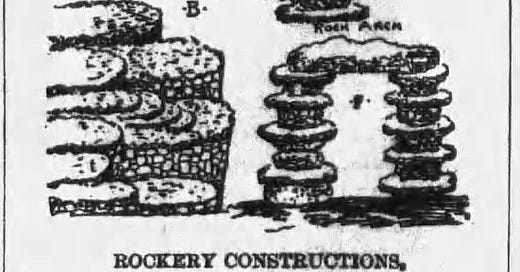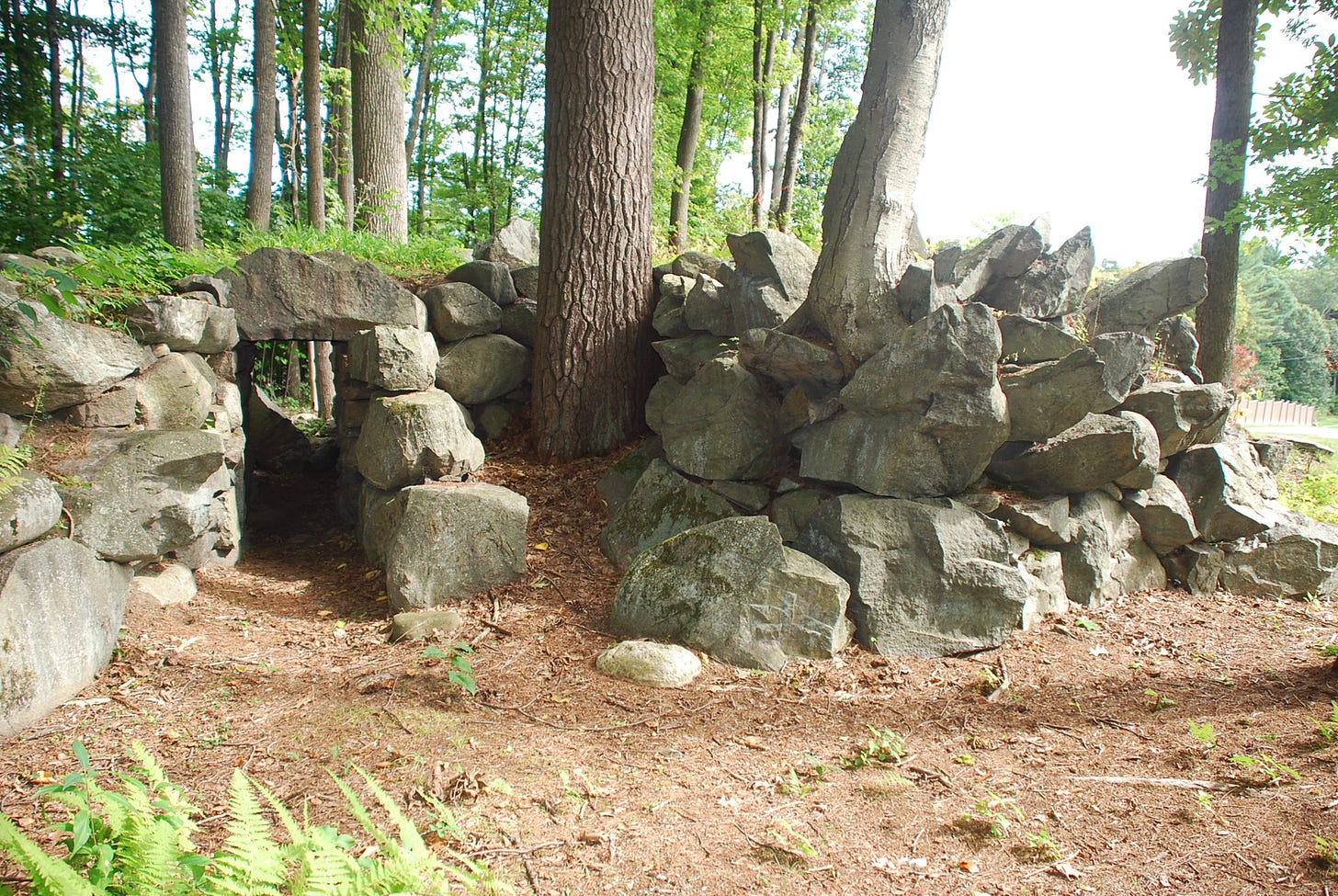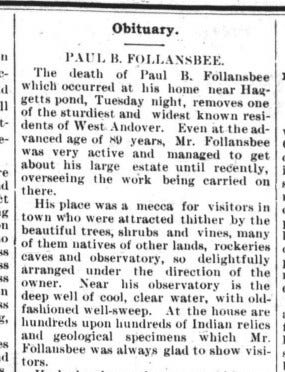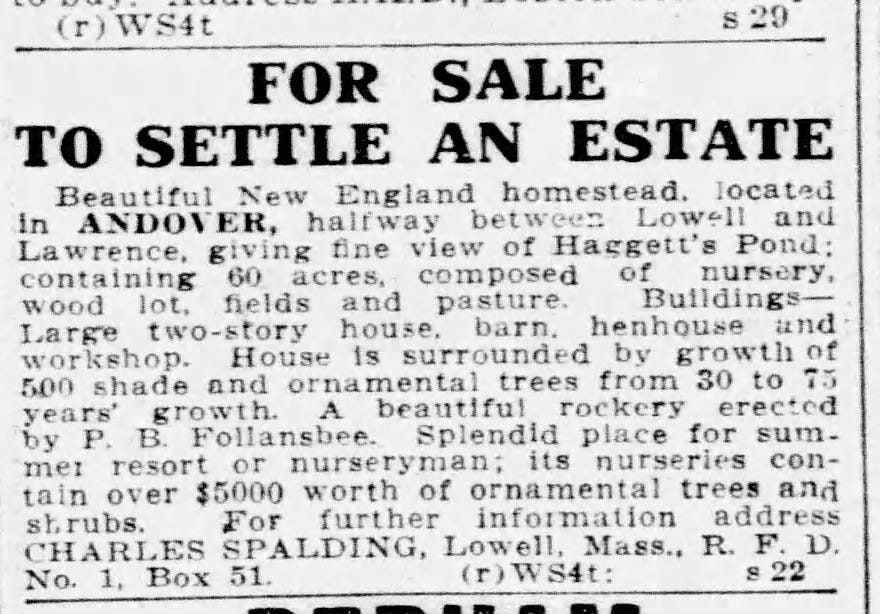In my previous post about Turtle Mound, I focused on the ground-level earthworks and the focus of archaeologists in the early 20th century. However, it was the above ground stone work that has been the subject of great theories, debates, and speculation from the late 1930s on.
Vikings? Irish monks? Ancient burial ground?
What I find fascinating about the debates and speculation is that the authors of the theories completely dismissed local history and knowledge about the site….less than 20 years after its purpose, construction, and use were well known.
The Follansbee Rockery
In 2019, the current owner of the site (AVIS, a non-profit land trust) commissioned a research study of the site. James Gage’s paper, “A History of the Paul B. Follansbee Rockery (a/k/a “Turtle Mound”), Andover Massachusetts,” is my source for this story. You can read the full report on the AVIS website.
The property southeast of Haggetts Pond in Andover, known today as Turtle Mound, was purchased by Paul Follansbee in 1835. Along with his son John, Follansbee ran a successful plant nursery selling trees, shrubs, and other plants.1 Follansbee was also interested in geology and the Native American history of his property.
To promote his nursery business, Paul Follansbee and his son created what would today be called a “destination.” The grounds were a showcase of his work and included an arboretum, greenhouse, displays of artifacts found on the property, and a “rockery.”
What is a rockery?
A rockery was a feature of a 19th century Victorian “natural garden.” What we might call a rock garden today. The “Fruits and Flowers” column of the May 10, 1894 Fall River Evening News included this description and images of the “Various Forms of Rock Work employed in the construction of the rock and alpine garden.”
“Rockeries are intended to develop plant life. They are arranged to hold soil for plants by suspending masses above masses, showing more plant life impressions in given space than any other garden arrangement. American Gardening illustrates and describes six forms used in rockery construction.”
The development of rockeries in public gardens, including the Boston Public Garden, appeared frequently in newspapers in the 1870s to 1890s.
The Follansbee rockery was described in local and regional newspapers.
July 2, 1880, the Lawrence American and Andover Advertiser included a description of Follansbee & Son,
“They have an extensive nursery, choice fruits, green house and great variety of flowers, a rockery, a fully-rigged miniature ship...There is not probably another place in town which presents so many attractions, and visitors are always received with courtesy.”
May 31, 1890, the Townsman printed another description of the Follansbee property and rockery in “An Interesting Place in Andover.”
“...a collection of rocks gathered from his land, consisting of bowlders [sic] and blasted stones...built up into a pile at least 8 feet high and covering at the base 20 feet square or thereabouts. In the sides of the mass are recesses, archived over of sufficient height to stand in and large enough to hold 6 or 8 persons, and running to the center is an arch large enough to pass through. A flight of rude stone steps leads to the top…”
On July 21, 1899, the Townsman ran a much longer article and detailed description of “Paul B. Follansbee’s Nursery, Museum and Arboretum” in the article “Ten Miles Awheel, Some Things That May be Seen on an Andover Bicycle Trip.” Mr. Follansbee was into his 80s when he toured the author around his estate.
“Then we came upon the ‘rockery’ artificially constructed but looking very natural with its caves and nooks. This was all blasted out of the ledge at the spot and placed with considerable labor in its present position. Near here also is the observatory reached by a winding path through the shrubbery and affording view of Haggetts pond and the West Parish…”
After Paul Follansbee’s death in May 1900, his son John stepped in to run the business.
Sadly, John died just eight months after his father and Paul’s son-in-law, Charles Spaulding (husband of his daughter Emma Winnifred) took over the business in 1901.
Charles Spaulding continued to run the business until at least 1910, when he was listed in the census as “manager nursery.” It’s not clear how long the nursery business continued after 1910.
This advertisement published by Charles Spaulding appeared in the Boston Evening Transcript on October 2, 1915. However, the family continued to own the property until 1919.
After the Follansbee family
In 1919, the property was purchased by Elof Erickson, a Swedish immigrant who listed his occupation as “stone cutter.”
The next year, Erickson sold the property to John Arnois, a French-Canadian Roman Catholic, who walled up part of the rockery to create a shrine to the Virgin Mary and was said to hold vesper services at the site.
Arnois held the property until 1924 when it was sold to Thomas and Annie Bradbury who owned the site until 1946.

The Follansbee nursery, arboretum, museum, and rockery were well-known from the mid-1800s until at least 1924.
So how did the Follansbee nursery and rockery become “Turtle Mound” in 1939? As James Gage wrote, it’s a “cautionary tale about how well meaning researchers created a mythology for an archaeology site. It has taken 80 years to undo it.” I’ll pick up the story in next week’s Mystery Monday.
Thanks for reading!
~Elaine











